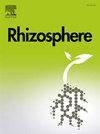Unveiling the microbial mysteries of mulberry rhizosphere in saline-alkaline soils
IF 3.4
3区 生物学
Q1 PLANT SCIENCES
引用次数: 0
Abstract
Mulberry is one of the top five global plants and is essential for managing saline-alkali soils and offering superior nutritional value for livestock. However, research on the archaeal, bacterial, and fungal communities in the rhizosphere soil of mulberry under saline-alkali conditions is limited. This study aims to elucidate the distribution characteristics of microbial communities in the mulberry rhizosphere across different soil layers using non-cultivation methods. The microbial community composition was analyzed through 16S rRNA and ITS gene sequencing from rhizosphere soil samples collected at layers ranging from 0 to 100 cm. Diversity analysis revealed significant differences in the diversity of archaea and bacteria across different soil layers, while fungal diversity remained consistent. Taxonomic analysis indicated that the dominant archaeal phyla were Crenarchaeota and Thermoplasmatota, while the main bacterial phyla were Proteobacteria, Actinobacteriota, Acidobacteriota, Chloroflexi, and Bacteroidetes. Fungi, the primary phyla identified were Ascomycota and Mortierellomycota. Notably, many of these taxa are considered beneficial for growth promotion and biological control. Linear Discriminate Analysis (LDA) and Linear Discriminant Analysis Effect Size (LEfSe) revealed 15, 29, and 7 biomarker microbes in the five soil layers, respectively. The biomarkers in different soil layers were mainly concentrated in single phyla or classes, suggesting that microbes with similar biological functions may survive across varying soil layers. The networks were dominated by positive correlations (98.45% of total edges), with strong connections between the upper soil layers. Archaeal diversity was significantly correlated with total carbon, nitrogen, and protein content in the soil, while fungal diversity was significantly correlated with available potassium content. No significant correlation was found between environmental factors and bacterial diversity. Redundancy analysis based on the top 20 genera and all ASV levels showed that different taxonomic levels were influenced by different environmental factors, with TK being the primary environmental factor affecting bacteria and EC influencing fungal communities. Additionally, the main functional profiles of archaea and bacteria were primarily nitrogen-related and carbon-related functional groups, while the most common functional groups for fungi were saprotrophs, plant pathogens, and wood saprotrophs. These findings suggest that the rhizosphere microbes associated with mulberry have significant potential for exploring microbial dark matter and resources, particularly in the remediation of saline-alkaline soils.
求助全文
约1分钟内获得全文
求助全文
来源期刊

Rhizosphere
Agricultural and Biological Sciences-Agronomy and Crop Science
CiteScore
5.70
自引率
8.10%
发文量
155
审稿时长
29 days
期刊介绍:
Rhizosphere aims to advance the frontier of our understanding of plant-soil interactions. Rhizosphere is a multidisciplinary journal that publishes research on the interactions between plant roots, soil organisms, nutrients, and water. Except carbon fixation by photosynthesis, plants obtain all other elements primarily from soil through roots.
We are beginning to understand how communications at the rhizosphere, with soil organisms and other plant species, affect root exudates and nutrient uptake. This rapidly evolving subject utilizes molecular biology and genomic tools, food web or community structure manipulations, high performance liquid chromatography, isotopic analysis, diverse spectroscopic analytics, tomography and other microscopy, complex statistical and modeling tools.
 求助内容:
求助内容: 应助结果提醒方式:
应助结果提醒方式:


